rolling, roaring pouring plunging, tumbling rumbling crashing, gushing, rushing sparkling breathtaking twirling swirling whirling ebb ripple eddy ruffle backwater misting soaking splashing current
Just 30 miles east of Seattle sits a little hamlet surrounded by mountains, tall Douglas Fir, and raging rivers. Fans of the 1980s cult classic “Twin Peaks” know all about North Bend and Snoqualmie, two Washington towns that served as the backdrop for the television show. Some of the original series, plus the reboot in 2017, was shot here, and fans flock to visit filming locations that still stand today.
But there’s so much more to these two towns other than FBI agent Dale Cooper, Laura Palmer, and director David Lynch’s fictional setting. Outdoor enthusiasts are drawn to the bike paths, hiking trails, fishing, camping, and other forms of recreation. Annual events, including Twin Peaks Day, attract people from the city and beyond. There are wineries and breweries, great small-town restaurants, galleries, gift shops, and some of the best soft serve ice cream this side of the Snoqualmie Pass served at a classic burger stand.
Explore the real ‘Twin Peaks’: Snoqualmie and North Bend, just outside of Seattle
Twin Peaks Day is celebrated on February 24th each year to commemorate the day Special Agent Dale Cooper arrived in the town of Twin Peaks in the TV series.
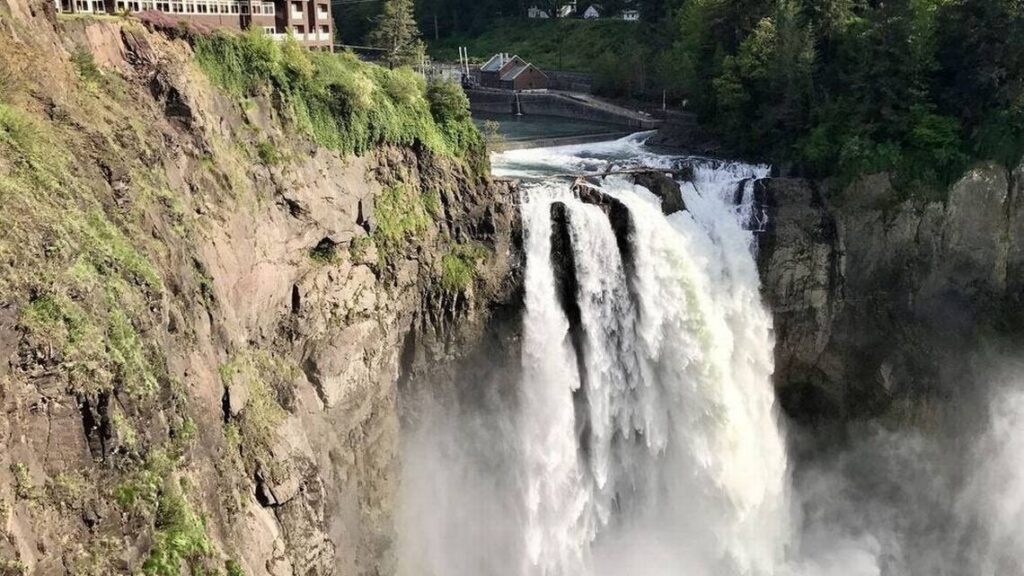
While directors did not directly relate the series to Lunar New Year they might have if consulting with the local Indian tribes. The Snoqualmie Tribe’s name means “people of the moon,” with their creation myth involving Moon the Transformer, who created Snoqualmie Falls and transformed various elements123. The tribe’s story revolves around Moon’s transformative actions and his significance in their culture. Moon is a central figure in their mythology, associated with creation and transformation. The tale of Moon the Transformer is a key part of Snoqualmie oral tradition, emphasizing the tribe’s deep connection to the moon and nature5.
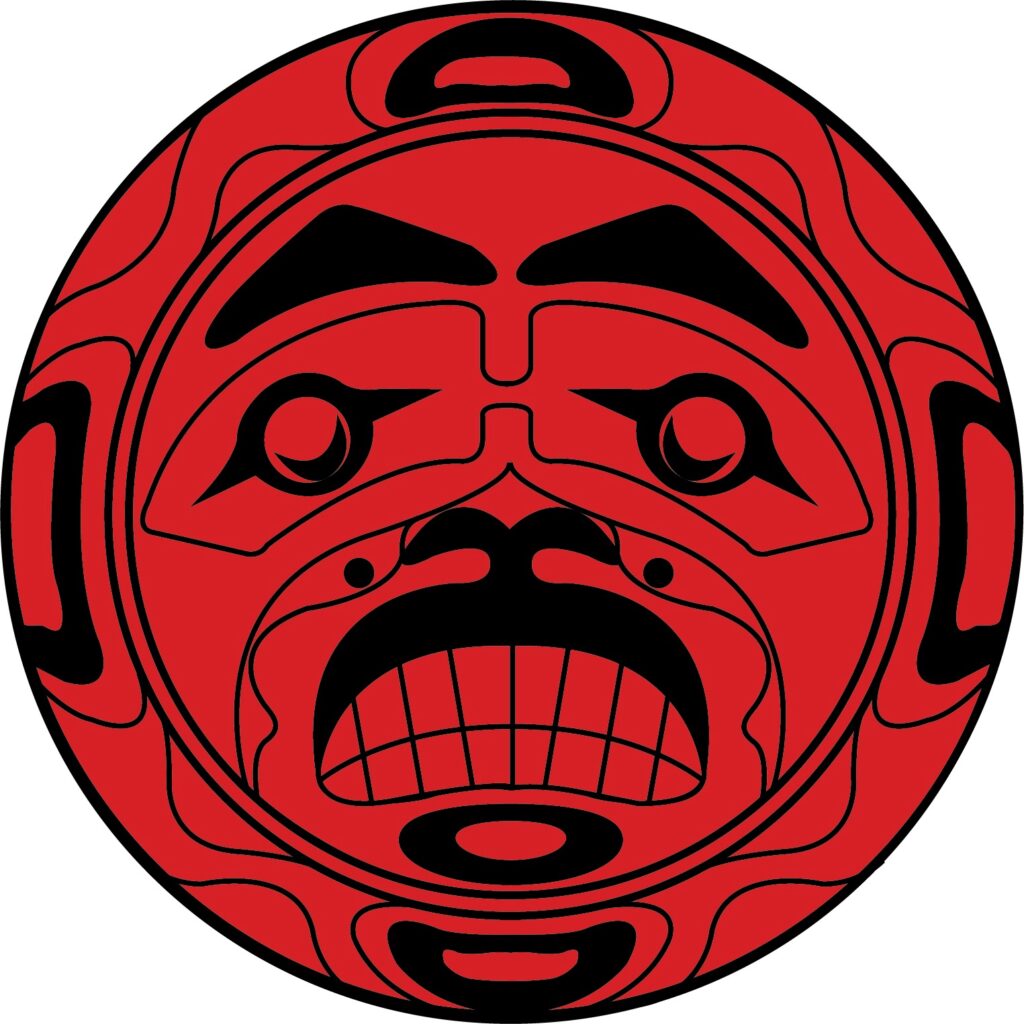
Lunar New Year, also known as Chinese New Year, is a significant festival celebrated in China, Korea, and Vietnam, with customs like giving red envelopes and setting off firecrackers3. In 2024 it was celebrated on February 24th. The miniseries “Twin Peaks” follows FBI Special Agent Dale Cooper as he investigates the murder of Laura Palmer in the mysterious town of Twin Peaks, uncovering dark secrets and supernatural elements2.
Visitors to North Bend, fans of Twin Peaks, can explore various sites related to the series. Some locations to visit include:
- Snoqualmie Valley Museum: Located at 320 Bendigo Blvd S, North Bend, WA 98045, this museum showcases the history of the Snoqualmie Valley, including exhibits related to Twin Peaks1.
- Twin Falls Natural Area: Situated at 47600 SE 159th St, North Bend, WA 98045, this natural area offers beautiful scenery and hiking opportunities2.
- Rattlesnake Lake Recreation Area: Found at 17905 Cedar Falls Rd SE, North Bend, WA 98045, this area provides stunning views and outdoor activities like hiking and picnicking3.
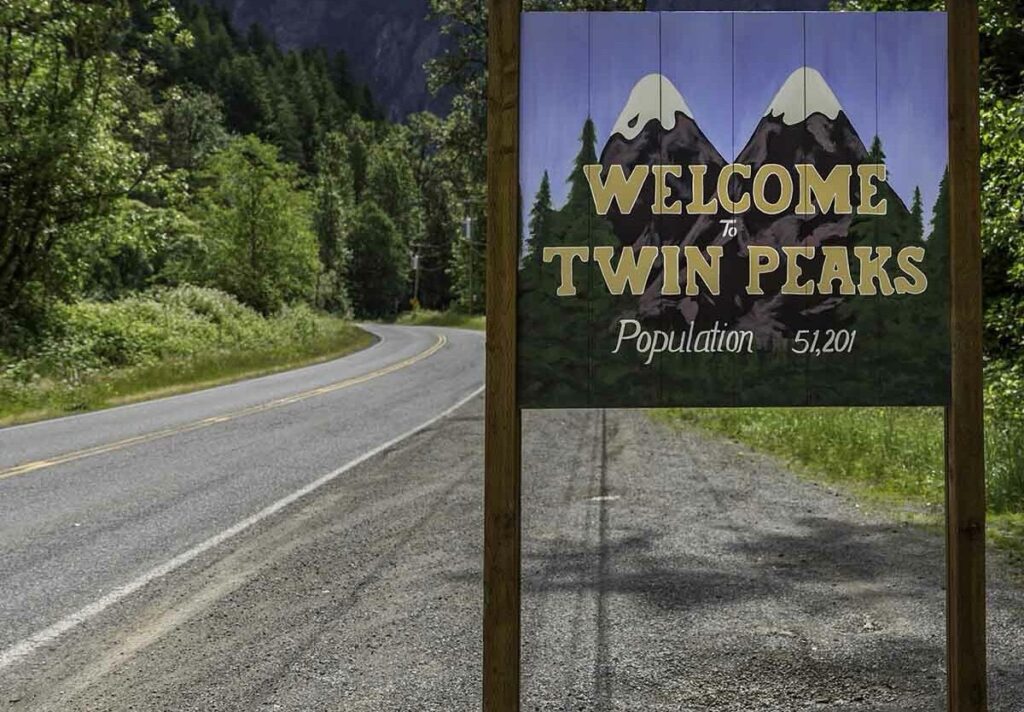
The area around North Bend was selected for filming Twin Peaks due to its picturesque landscapes, including forests, waterfalls, and mountains that suited the show’s mysterious and eerie atmosphere. The Great Northern Hotel in the series is inspired by the Salish Lodge & Spa in Snoqualmie Falls. Additionally, locations like Twede’s Cafe (known for its cherry pie), Snoqualmie Falls, and the iconic “Welcome to Twin Peaks” sign are popular spots for fans to visit5.
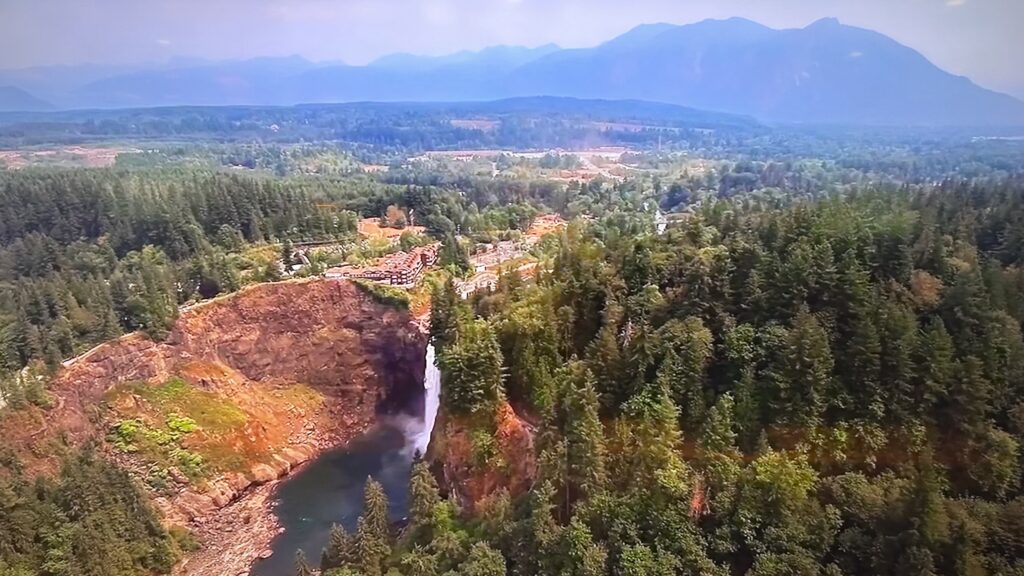
HOW SNOQUALMIE FALLS WAS FORMED
There is a turbulent geological history layered beneath these cascading waters of Snoqualmie Falls, involving tectonic plates, volcanic centers, glacial depositions, and earthquake fault zones.
The Modern Cascade Range
The Cascades are a relatively young geologic feature formed by the pressures of plate tectonics. Uplift of the modern Cascades started in the Miocene epoch and continues today.
As the Juan de Fuca ocean plate advanced into the area and slid under the continent, the land folded and magma developed from the subducted oceanic plate, forming Cascade volcanoes such as Mount St. Helens, Mount Rainier,
Juan de Fuca Plate
Mount Baker, Glacier Peak, and Mount Hood. Today, the Cascade Range accumulates heavy snow only in the fall and winter months. The Snoqualmie River originates as snowmelt on the crest of this range.
ine cascade kange near the headwaters of the
The Falls’ Icy Birth
The Pleistocene is the geologic epoch lasting from 2.6 million years ago to about 10,000 years ago, most often referred to as the Ice Age. During that time, massive glaciers covered Canada and the northern United States, and glacial advance and retreat repeatedly scoured the Puget Lowlands, creating much of today’s spectacular landscape.
As glaciers of the Pleistocene epoch – some of them 2,000 feet thick – grew and receded, ice filled river channels and etched terrain.
The largest glacial episode in the Pacific Northwest, called the Vashon Stade, occurred between 11,000 and 18,000 years ago. Vashon ice pushed the ancient Snoqualmie River to the south side of the upper valley. As the glaciers retreated, the river caused rapid erosion through the layers of gravel, sand, and clay left by the ice. Eventually, the river eroded down to the hard andesitic bedrock of an ancient volcano, slowing down the erosion of sediments in the upper valley.
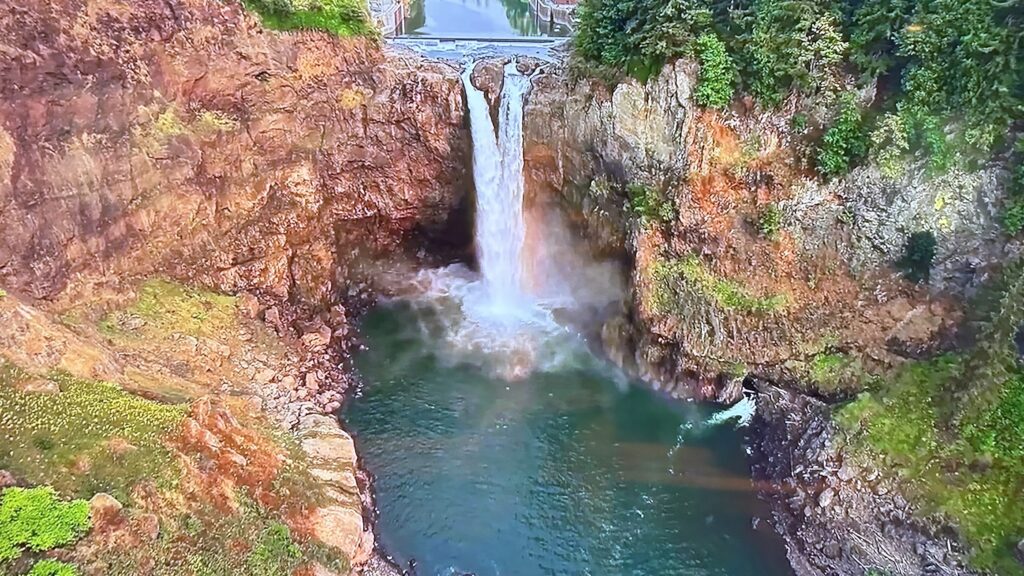
However, rapid erosion downstream of the bedrock continued, and over time a steep ledge formed at the edge of the volcanic rock, creating a cataract. Water falling over this cataract began eroding the rock, and the spectacular Snoqualmie Falls was born.
MOUNTAINS, EARTHQUAKES, AND LAND FORMATION
The Pacific Northwest has been undergoing continuous geologic change for its entire history, and this shifting process is still occurring today.
Volcanic Rock
Before the Ice Age, and before the formation of the modern Cascade Range some 13 to 30 million years ago, volcanoes spewed molten rock in many parts of the Pacific Northwest. This Cascade arc of volcanic activity, created by melting of the Juan de Fuca Plate as it plunged under Washington and Oregon, produced a magma that has become the dominant rock of the region – the hard andesite you see exposed in the cliff face surrounding Snoqualmie Falls.
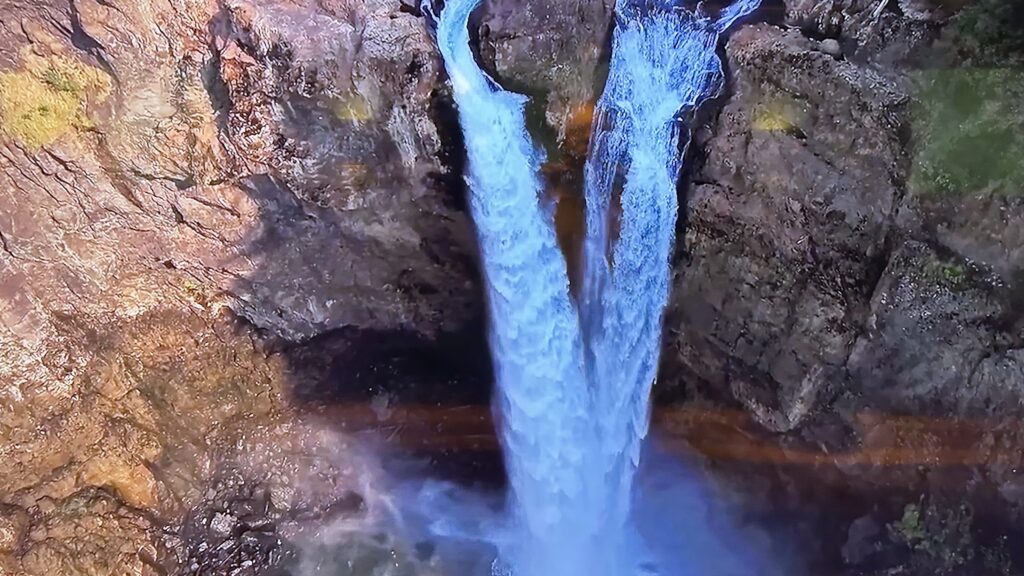
I’m Geologic strata of Snoqualmie Falls and the surrounding area
Snoqualmie Falls flowing over volcanic rock shelf.
Ancient Volcanoes
Recent work by the Washington State Department of Natural Resources (DNR) revealed that Snoqualmie Falls flows over rock of volcanic origin – the remains of a 20 million-year-old volcano, formed during the Miocene epoch above a major fault zone. Strata along the falls include thick andesite lava flows and volcanic breccias, including volcanic bomb breccias (see photo). Breccias are rocks made of rock fragments that have been cemented together. These rocks are part of a volcanic center (volcano) that was likely fed by the same magma that created the granite (Snoqualmie batholith) forming the Cascades (see illustration).
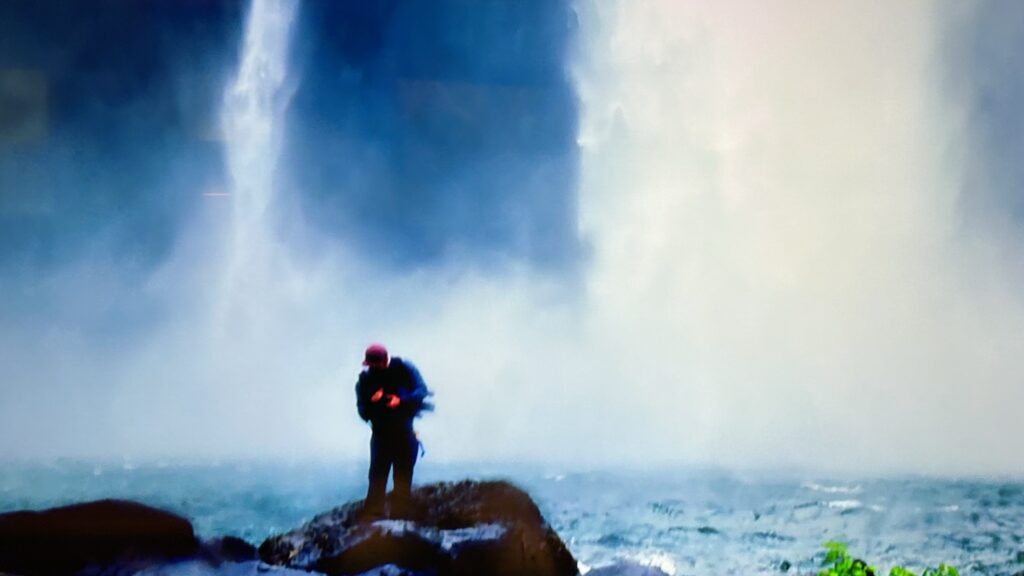
DR research shows that this fault zone, the Rattlesnake Mountain fault, is an extension of the southern Whidbey Island fault, and that it extends through the Snoqualmie River valley in the vicinity of the towns of Carnation, Fall City, and North Bend, intersecting with the Seattle fault very close to Snoqualmie Falls. Past movement on the Rattlesnake Mountain fault zone has uplifted Snoqualmie River sediment laid down prior to the last ice age into the surrounding hills.
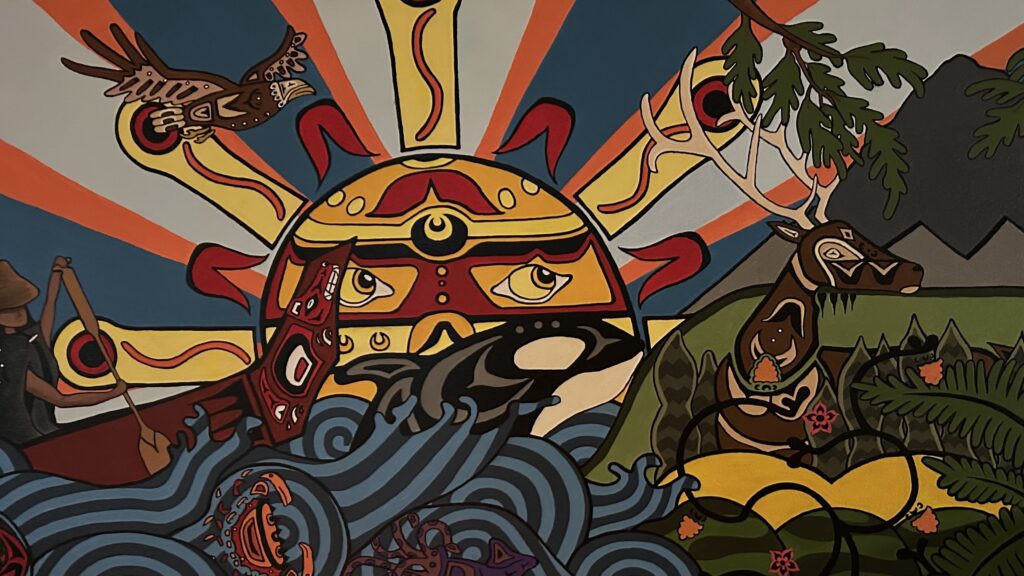
– dukwibal
Transformer’s People – sdukwalbixw
Pal tudi? tuha?kw… A long time ago, two Snoqualmie sisters were admiring Stars in the sky. “Oh Sister, I will marry the Red Star and you will marry the White Star.”
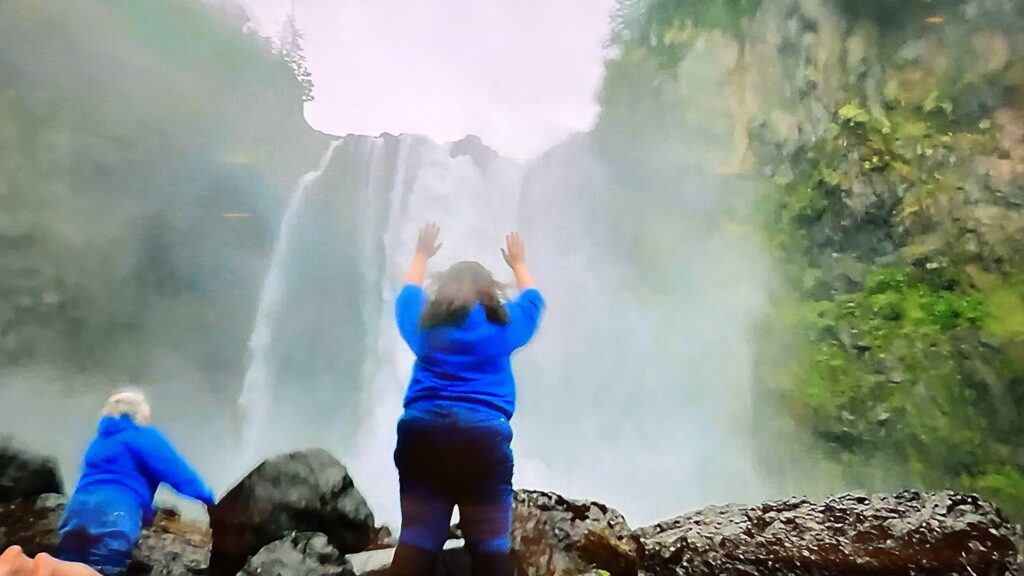
The two sisters fell asleep and when they awoke, they found they ad been taken to Star Country by Star men. One sister married the White Star and one sister married the Red Star. One of the sisters had a baby. He was the Transformer She took him with her when she and her sister went gathering. The Star People told them to be careful when gathering their roots and not to dig too deep. One day when they were out gathering one of the sisters poked a hole through the sky and they could see all the way to their homeland below! The sisters carefully covered the hole and planned their return to their home. They braided cedar into a rope which they dropped through the hole and with the baby on his Snoqualmie mother’s back, the two sisters climbed down, back to their home. Their relations were very joyful and happy to see them again.
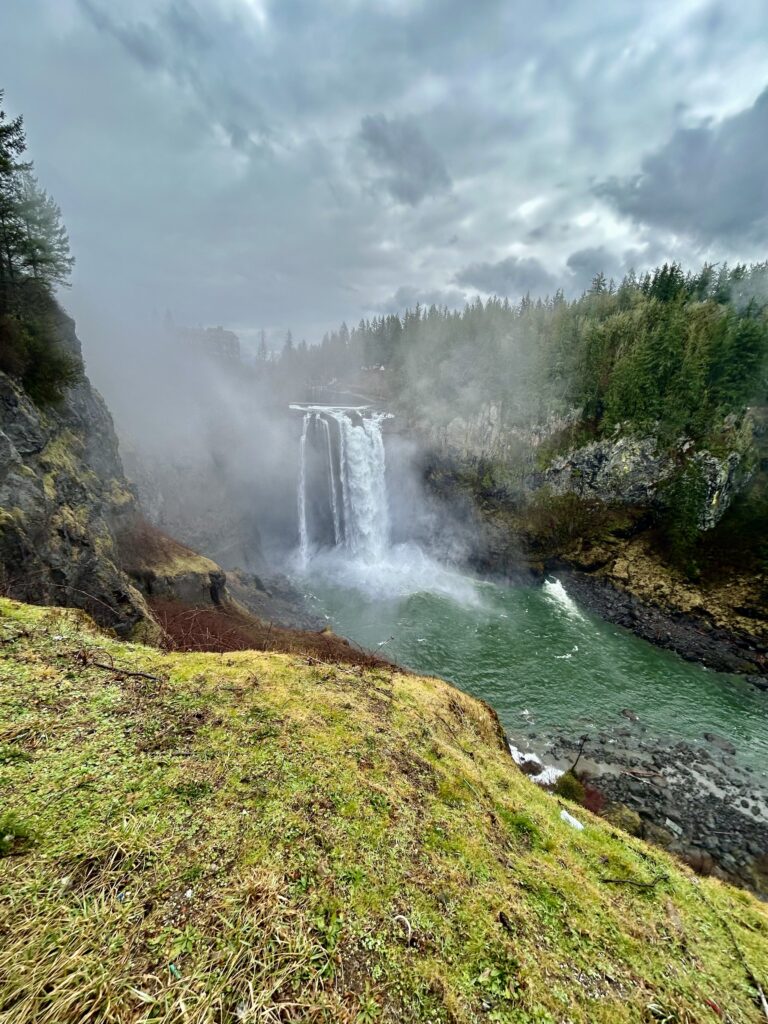
Relations from all around gathered to celebrate their return. The baby grew up strong and healthy among his Snoqualmie mother’s people. He had special powers and knew he had work to do for the People.
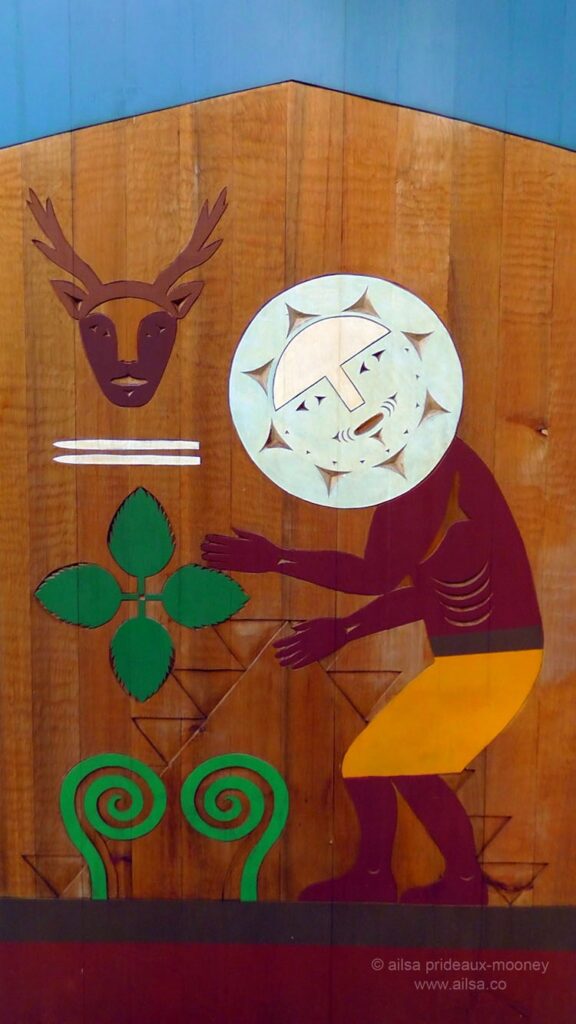
He was the Transformer He went on a great journey. During his travels he changed everything
When he came upon a huge fish weir that Raven had built, he urned the weir to stone and the thundering water rushing over it became Snoqualmie Falls.
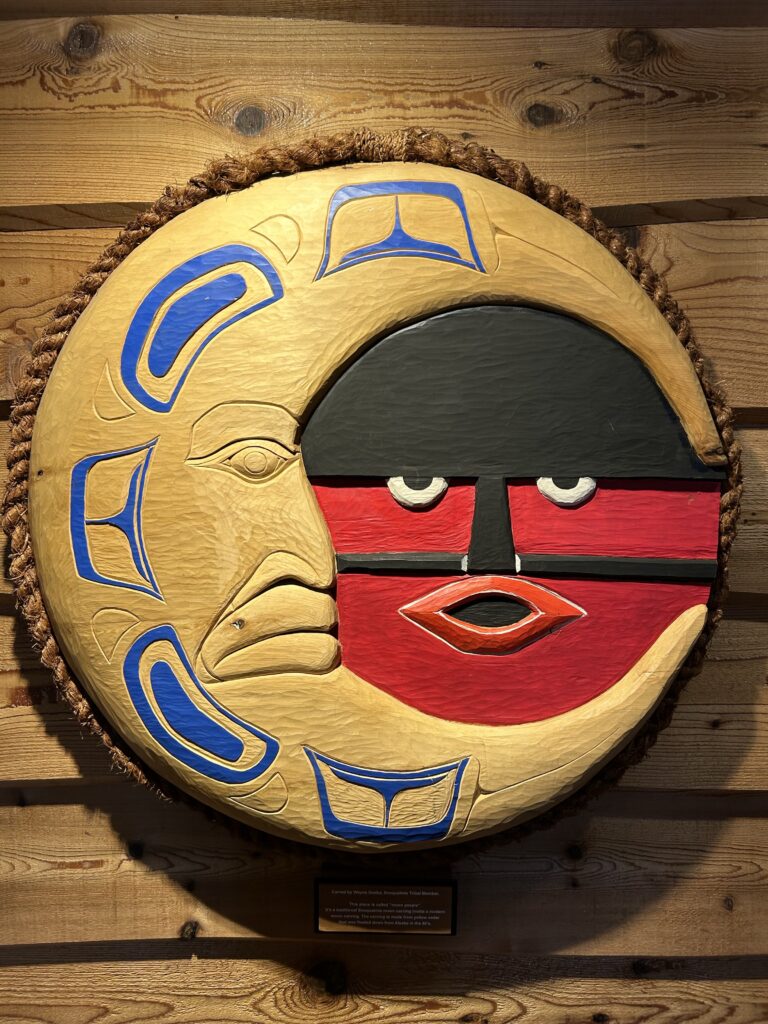
There, the Transformer, Moon, created the first Snoqualmie man and woman. He then climbed back into the sky to his Star father’s people, where he can still be seen today. He provides light through darkness
Traditionally these were told over many nights at gatherings. We share with you today this highly condensed version.
TIME IMMEMORIAL
For thousands of years, Snoqualmie Falls flowed freely to the plunge pool below, creating legendary mists that carried prayers, connecting worlds. These Falls have been a revered sacred place since time immemorial for the Snoqualmie People.
The Falls also served as a meeting place for the great Indian Peace and Trade Councils from the North, South, East and West. It was, and continues to be, recognized as a spiritual place of connection and healing by Snoqualmie and surrounding Tribes.
The Snoqualmie People have been on these lands since time immemorial. The archaeological record provides some context for just how long that is.
Archaeological sites show habitation at Tolt (present day Carnation), Fall City, and Snoqualmie that are at least 4000- 8000 years old. Sites along Lake Sammamish are at least 10,000 years old. A site near Redmond is 13,000 years old.
For comparison:
- Approximately 5000 years ago, the oldest known form of writing was created in Mesopotamia.
- Approximately 230 years ago in 1792, the first Europeans sailed into Puget Sound.
- Approximately 160 years ago, in 1855, the Snoqualmie signed the Treaty of Point Elliott.
- Approximately 120 years ago, in 1889, Washington became a state.
We are the sdukwalbixw, People of Moon. We have lived, hunted, gathered, and fished in this area for as long as the earth and rivers remember. We are still here today, caring for the land, water, fish, and game that dukwibel gave us. sqwed is our birthplace. These mists carry our thoughts and deliver blessings and healings. The rushing waters give us the strength to keep our traditions alive, and we continue to thrive in modern times.
The Snoqualmie People are still here.
Approximately 120 years ago, in 1889, Washington became a state.
The Snoqualmie People are signatories on the Treaty of Point Elliott of 1855. Among other things, the Treaty ceded tribal lands, promised reservation lands for signatory tribes, and guaranteed reserved rights including gathering, hunting and fishing rights. The Treaty of Point Elliott recognizes the Tribe’s sovereignty and government-to-government relationship with the United States of America. The United States’ treaty promises, however, have never been fully upheld.
The Snoqualmie Indian Tribe and its members continue to fight to ensure the Treaty is honored through work laid down by past generations. Today’s Snoqualmie Tribal members continue to fight for our rights, ensuring them for future generations to come.
POWER PLANT BLASTS THE FALLS
When Charles Baker looked upon Snoqualmie Falls and felt what so many had before him, he mistook that powerful energy as something to be diverted, harnessed, and sold for profit. To the Snoqualmie people, the blasting of the Falls to build a hydroelectric facility that brought electricity to the new and growing City of Seattle at the nding of the 1800s was an incalculable cost to our people.
It desecrated our place of Creation.
In 1898 there was no process for the public nor the Snoqualmie Indian Tribe to have input on whether the plant should be built at all. Falsely portrayed as energy generated without consequence, the hydroelectric plant has brought destruction that has impacted our sacred site and our people to this day. The free-flowing cycle of water and mist that flowed for thousands of years was violently interrupted by diverting the river water to underground turbines, bypassing its sacred journey over the Falls to the plunge pool 268 feet below.
During the Termination Era of the 1950s, the Snoqualmie Indian Tribe lost its recognition as an Indian tribe by the United States. Despite this situation, the Snoqualmie people have remained steadfast and maintained our strong connection and exercised our spiritual traditions as caretakers of our Sacred Snoqualmie Falls.
1989
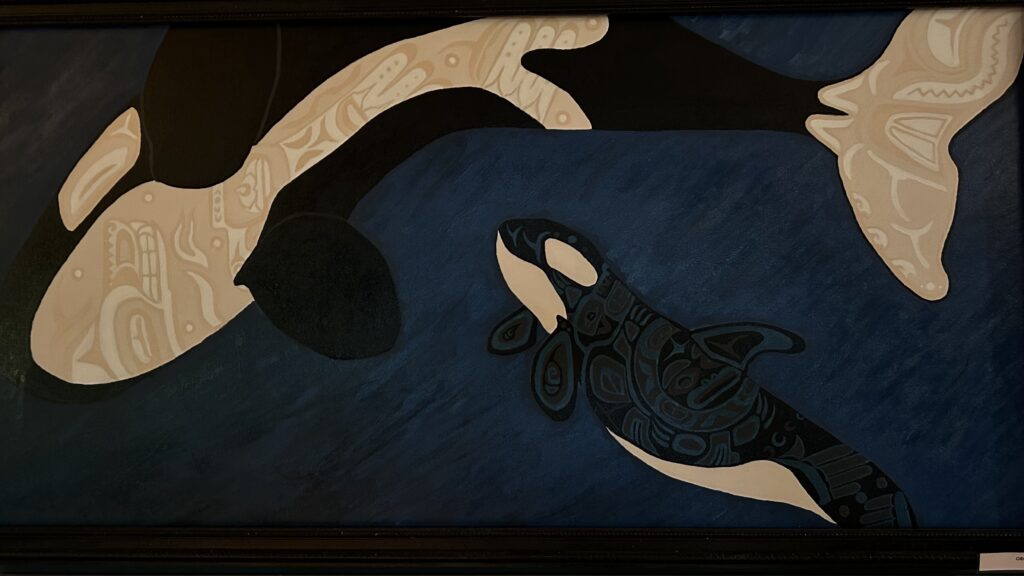
In 1989, the utility company Puget Power (now known as Puget Sound Energy) began preparing their application for a 40-year federal license to continue operating the plant at the Falls. This application proposed an increased diversion of water and blasting of the face of our sacred site.
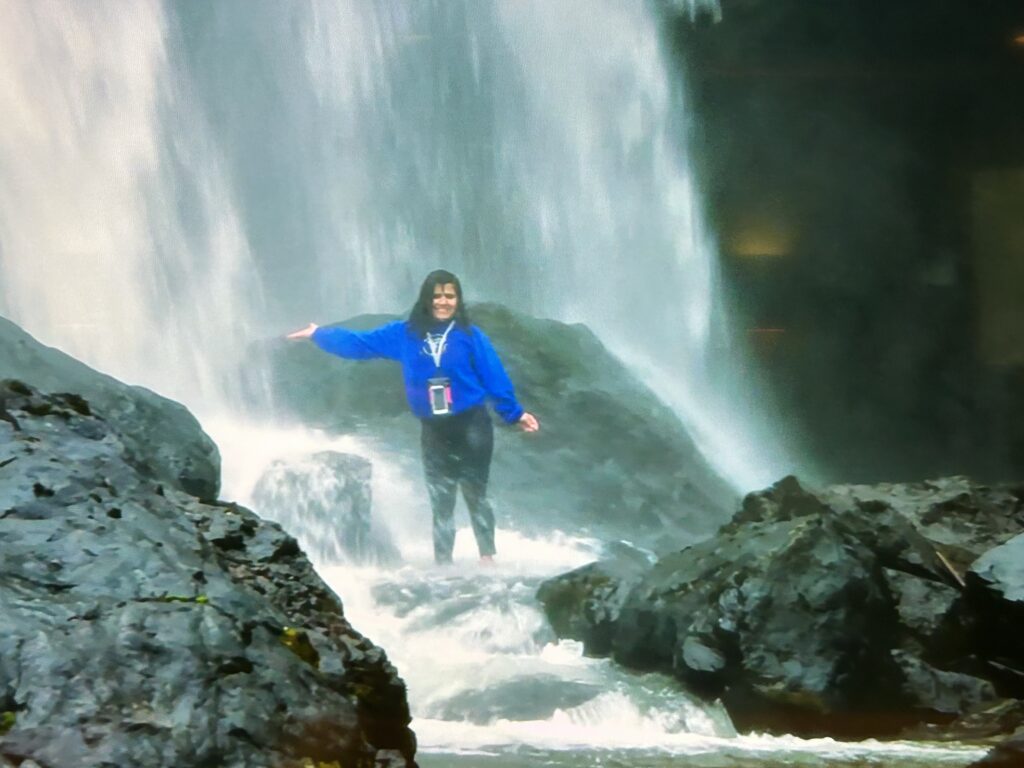
The unacceptable plans led the Snoqualmie Indian Tribe to take a public stand against the development in committing to uphold our sacred responsibility to protect sacred Snoqualmie Falls. Snoqualmie Tribal leaders, elders, and spiritual teachers said the time had come to publicly oppose such development by educating and sharing our responsibility and deeply held sacred connection. Although it was difficult for the Snoqualmie People to speak publicly avout their innermost and deepest spiritual selves, it was necessary in order to seek the preservation of our religious rights and to stop irrevocably impacting our strong spiritual connection.
1992
A TRADITIONAL CULTURAL PROPERTY
“A Traditional Cultural Property (TCP) is a property that is eligible for inclusion in the National Register of Historic Places (RHP) based on its associations with the cultural practices, traditions, beliefs, lifeways, arts, crafts, or social institutions of a living community. TCPs are rooted in a traditional community’s history and are important in maintaining the continuing cultural identity of the community. The cultural practices or beliefs that give a TCP its significance are, in many cases, still observed at the time a TCP is considered for inclusion in the NRHP. Because of this, it is sometimes perceived that the practices or beliefs themselves, not the property, make up the TCP.”
(Department of the Interior, National Parks)
In 1992, Snoqualmie Falls was determined eligible for listing on the NRHP as a TCP. This was a significant step, as the listing documented the Snoqualmie Indian Tribe’s history, culture and continued presence in the region at our sacred Snoqualmie Falls. It was also a new mechanism to legally support the Tribe in its work to protect the Falls from future irresponsible development.
Puget Sound Energy (PSE) opposed the listing of the Falls as a TCP which delayed the official listing for 17 years until 2009 when PSE finally withdrew their objections.
On September 2, 2009, Snoqualmie Falls was finally listed on the NRHP as a TCP, acknowledging its rich precontact history and sacred, spiritual and cultural significance of the area to the Snoqualmie Indian Tribe.
FEDERAL RECOGNITION
During the Termination Era of the 1950s, the Snoqualmie Indian Tribe lost its recognition as an Indian tribe by the United States. Nearly 150 years after signing the Treaty and after decades of petitioning, the Snoqualmie Indian Tribe regained Federal Recognition in 1999.
On October 6, 1999, with all hurdles and delays resolved, the U.S. Department of Interior affirmed its August 1997 decision and our final determination of Federal Recognition was published in the Federal Register. Having formal acknowledgment of our status as a sovereign nation was especially critical to our efforts to protect and preserve
Snoqualmie Falls as our sacred site.
TWO SISTERS RETURN
In 1999, the Snoqualmie Ridge development which was contested by the Snoqualmie Indian Tribe was expanding and plans were approved by the City of Snoqualmie to include land up to the rim of Snoqualmie Falls. The expanded proposed development would have included up to 370 dwelling units and 215,000 square feet of commercial development which would have desecrated sacred burial grounds and decimated the TCP.
With the continued threat of development encroaching the sacred landscape of Snoqualmie Falls and adjacent sacred lands, the Snoqualmie Indian Tribe, through its collaboration with the SFPP, initiated discussions with various individuals, conservation groups, and local governments to protect an area sacred to the Snoqualmie People and special to the entire region.
These discussions led to the creation of the Snoqualmie Preservation Initiative which preserved lands in the King County area including the 154 acres of land slated for development near the Snoqualmie Falls. This collaborative conservation initiative was unique in its time. The Grant Deed of Conservation Easement was filed on June 27, 2001, permanently limiting development on the property.
“The Legend of the Two Sisters And The Sky Land Boy Star Baby” by Chris Hopkins
The conserved 154 acres, now managed by Forterra, the City of Snoqualmie and the Snoqualmie Indian Tribe, is named Two Sisters Return, after the two Snoqualmie sisters from the Tribe’s creation history who returned to their people with the baby Transformer.
SAVE SNOQUALMIE FALLS
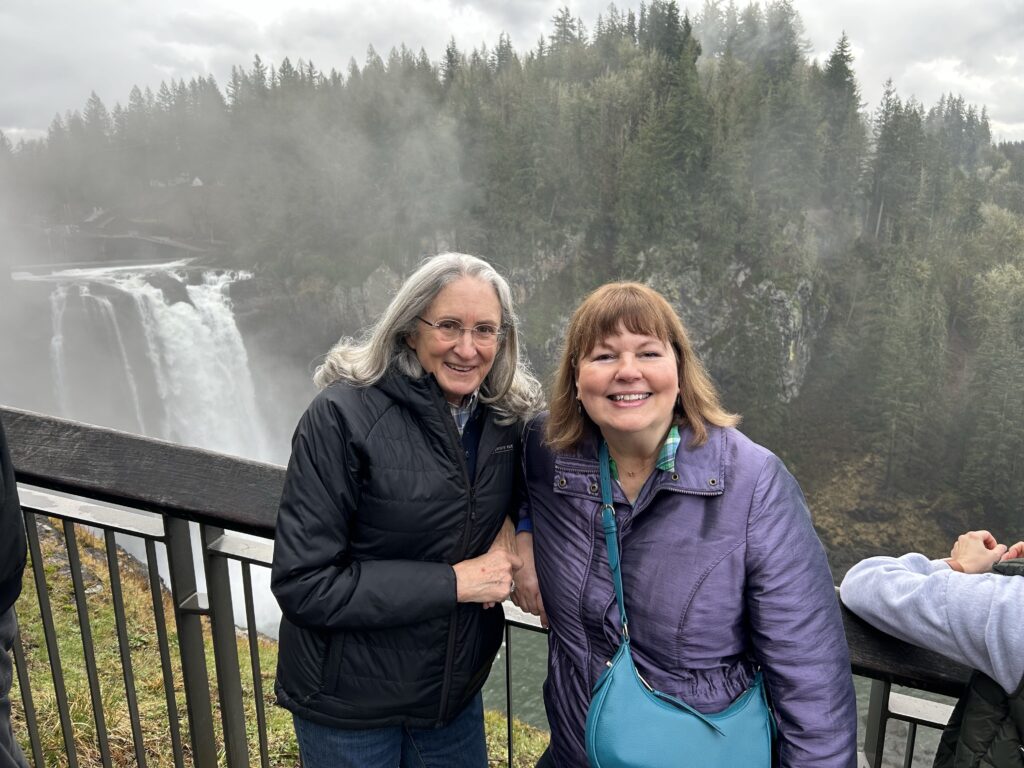
In 2015, the Save Snoqualmie Falls Campaign was created to highlight and raise awareness of yet another approved development which threatened the area near the Falls. Like the developments proposed before it, this irresponsible development would have desecrated ancient burial sites and sacred land, and would have been visible from the Falls.
“The Snoqualmie Tribe has worked to protect Snoqualmie Falls from irresponsible development. Our tribe is not against development. In fact, we are proud to be a major employer in this region. But development on sacred land is irresponsible. We oppose the construction of the roundabout and the proposed housing development because we have a responsibility to protect our sacred land, clean water, forests and open spaces.”
Op Ed in Seattle Times, October 2015
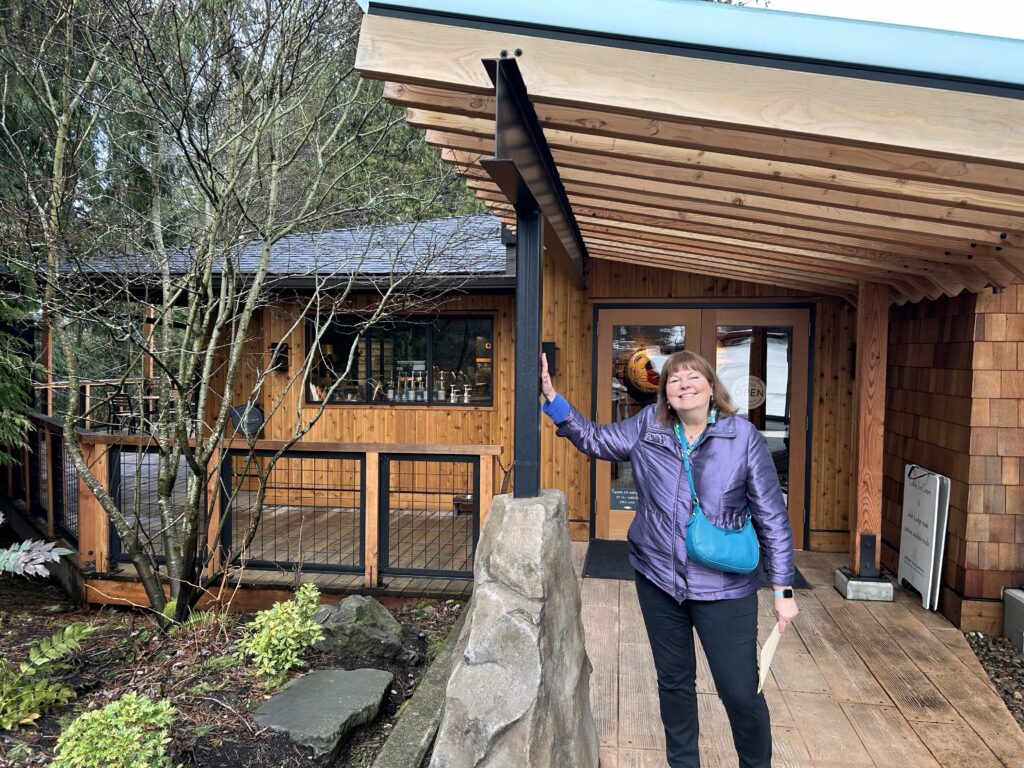
SNOQUALMIE TRIBE PURCHASES THE SALISH LODGE & SPA, & ADJACENT LANDS
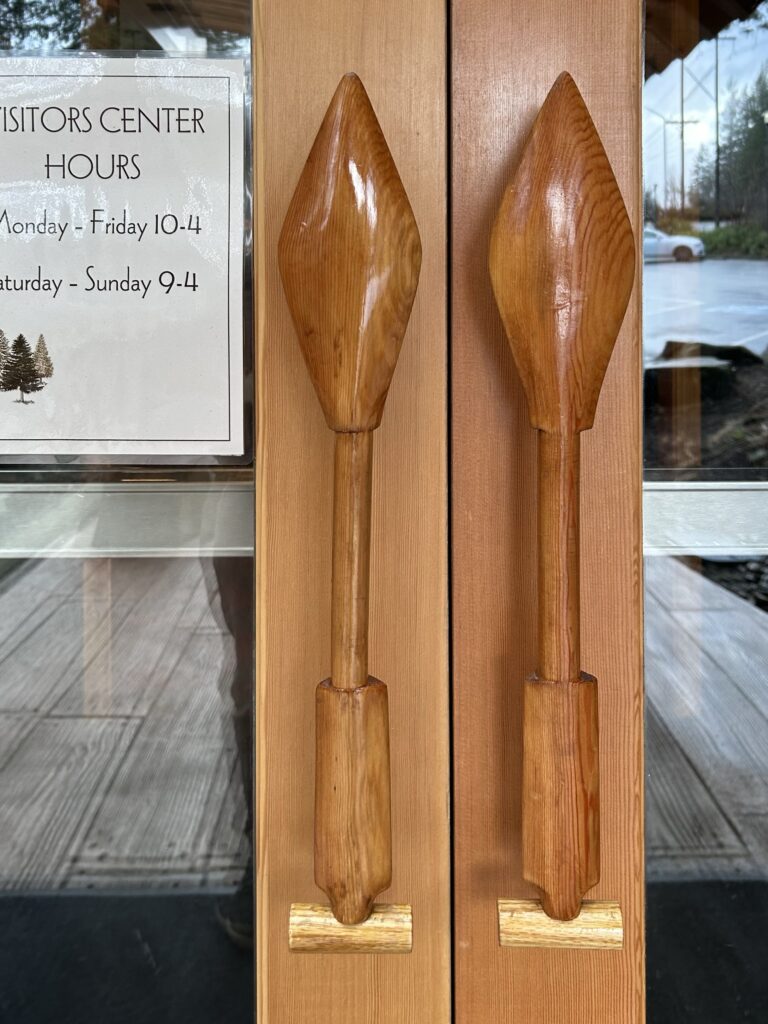
On October 31, 2019, the Snoqualmie Indian Tribe was officially able to secure its sacred landscape and ancient burial sites, prohibiting the approved planned development from proceeding by purchasing the Salish Lodge & Spa, this Snoqualmie Falls Gift Shop, and 45 acres of surrounding land.
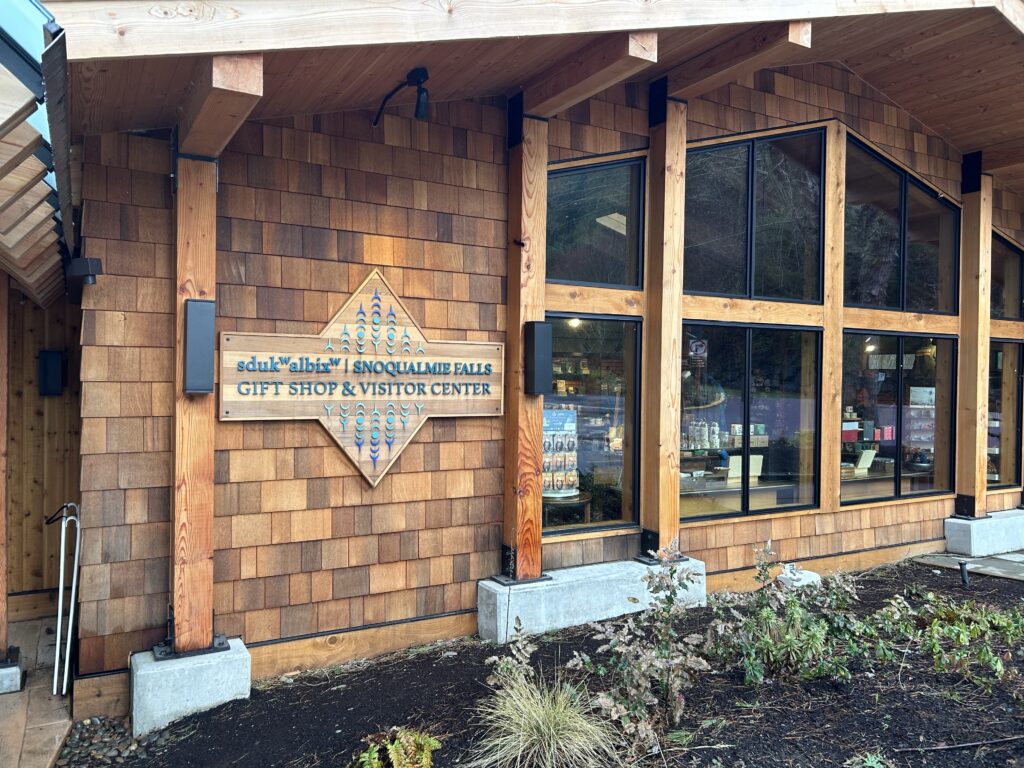
With this historic reclamation, the Snoqualmie Indian Tribe issued this statement:
“Snoqualmie Falls is a sacred place and a globally beloved landmark, and the Salish Lodge is an iconic Northwest institution. The Snoqualmie Tribe is committed to enriching the experience for Lodge guests by sharing the Tribe’s story, meaning, and history of the Falls and the Snoqualmie people who have cared for it since time immemorial.”
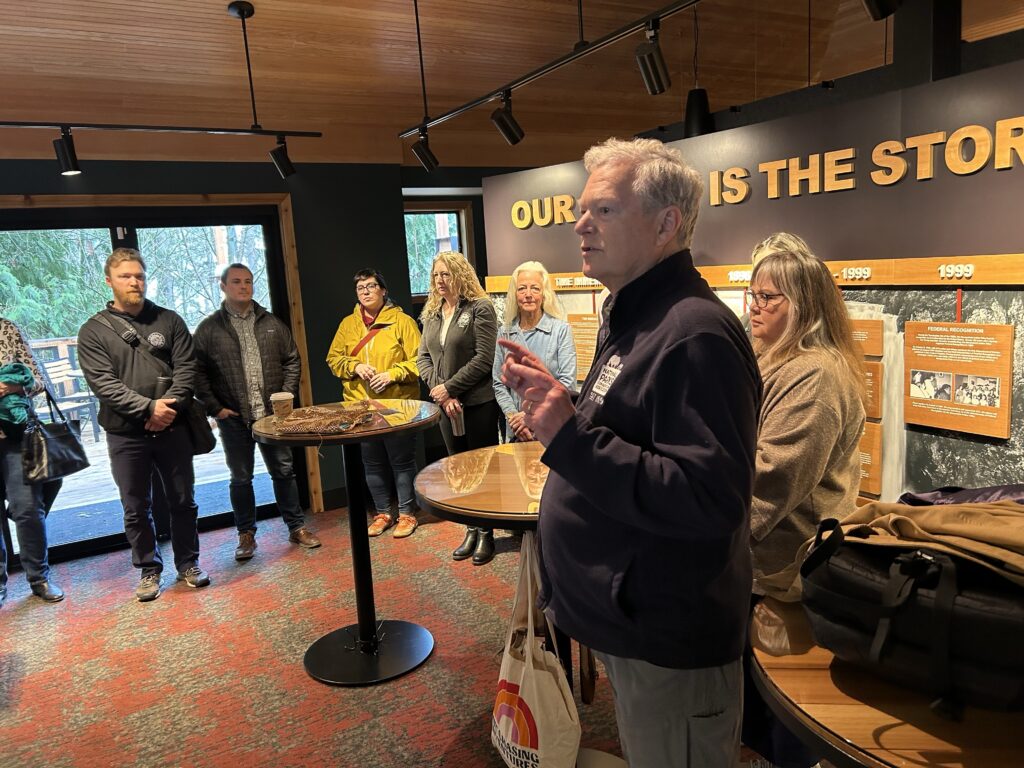
Let the Spirit Flow
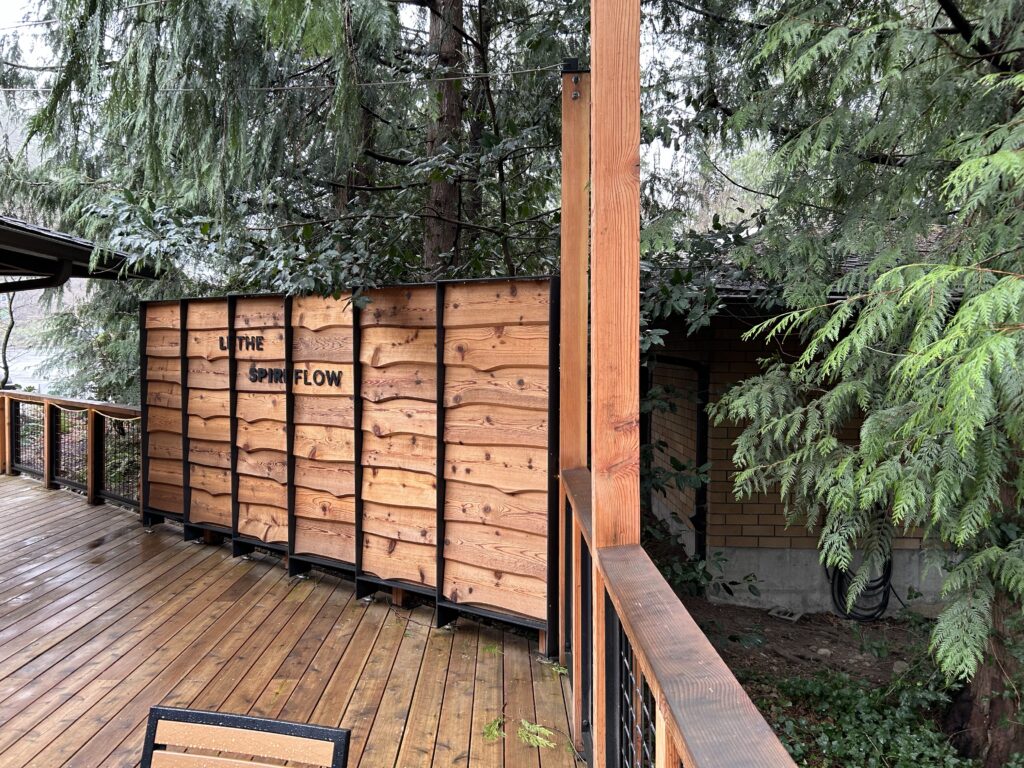
Since the beginning of time when the Transformer changed the vorld to a home for the people, the Snoqualmie People have been the Spiritual Stewards of Snoqualmie Falls and its surrounding lands. This area was given to the people to take care of and to gain nourishment From both physical and spiritual. The mists carry our prayers. The rushing waters strengthen us.
The Snoqualmie a Tribe’s creation history has been passed down since time immemorial. These teachings say that on each river, a people were created for that river to live, fish, hunt, and to care for that river for all time. The Snoqualmie Indian Tribe has honored this teaching by continually meeting to perform our spiritual practices, an by lighting to protect Snoqualmie Falls and our other sacred lands from encroaching threats.

As long as the hydropower facility remains, and as long as irresponsible development encroaches sacred Snoqualmie Falls, the Snoqualmie Indian Tribe will remain steadfast in upholding its sacred responsibility to protect and secure its most sacred and beloved site.
We are the Snoqualmies who stayed. We remain. We are still here. We raise our hands to those who came before us, who carried the work for our next seven generations and ensured we had a future for our people.
We welcome you to our Snoqualmie Ancestral Lands – Snoqualmie Pass, Snoqualmie National Forest, Snoqualmie Valley, Snoqualmie
River and Snoqualmie Falts, on the waterways and in the surrounding land.
We are Snoqualmie: We are Snoquartie Falls. Let the Spirit flow.



Where was Twin Peaks filmed? The top 5 filming locations from the iconic David Lynch series
https://ew.com/where-twin-peaks-was-filmed-8609942